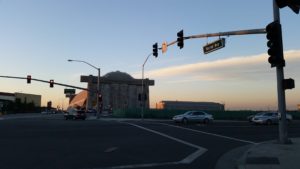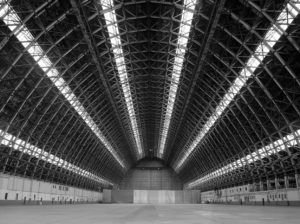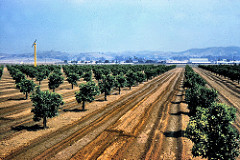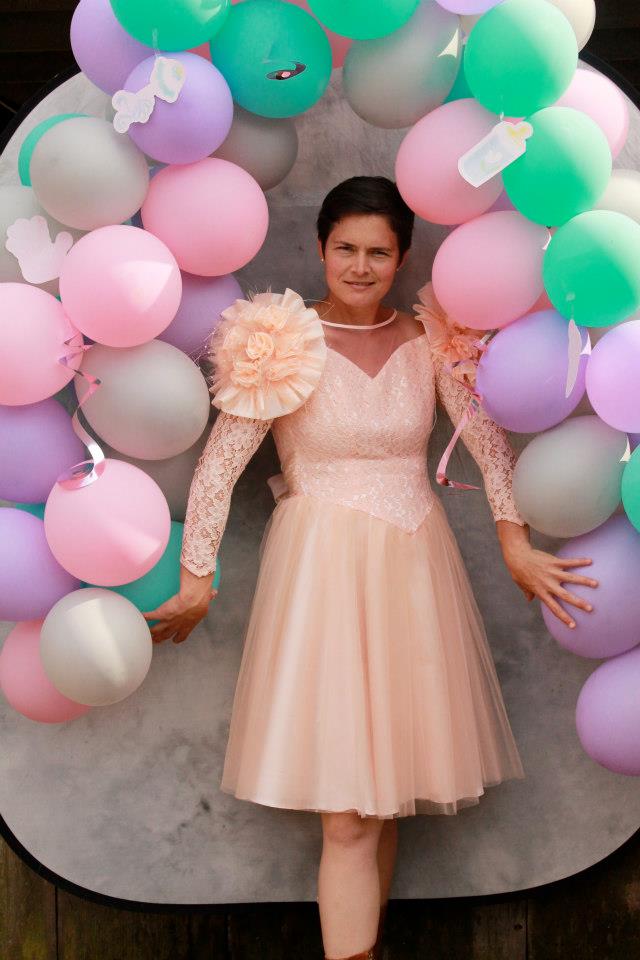Lighter Than Air

Photo credit: Mary Birnbaum
There are only two interesting structures in Tustin, California, the city where I now live. They’re a pair of identical military blimp hangars, built in 1942 from Oregon Douglas fir. The city is tearing them down. These are among the biggest wooden structures on the planet; indeed, they contain the largest covered, unobstructed open space of any buildings in the world. They’re hulking, beached-whales of engineering: each of the elongated domes is eighteen-stories high and as long as three football fields. They sit on some eighty-five acres of drought-brown grass, and tract development creeps up on all sides. The first to go will be the south hangar. From the moment I learned of its demolition, I knew I had to climb it.
I first saw the hangars twelve years ago, while driving one night with my then-boyfriend, now husband. We’d been fooling around in the front seat of his Buick in the parking lot of a community college. (I really love the phrase “fooling around”. Like we were playing Uno and braiding each other’s hair.) As we drove away, giddy and sweaty, we made a wrong turn somewhere and ended up at the edge of a chain link fence, beyond which loomed something massive, gray, and arcing. I felt like we had traveled to a different world. I gaped at the very scale of the structures, especially in the context of their suburban environs. Under the moonlight they were pure science fiction.
I asked my boyfriend, “Where are we? Are we allowed to be here?” and he laughed.
He turned his face toward the mammoth buildings and said, “Those are hangars from World War II.”
I asked, “So what’s in there now?”
He said, “Just weather.” I looked at his handsome profile and beyond it, out the window at the improbable fantasy world—the stars and spaceships—and felt the thrill of being lost under the dark, widening sky. New love hummed over my skin. I couldn’t know then that a dozen years later, seven years and two kids deep into a marriage, I would be a resident of this alien place, and that the hangars would so preoccupy my mind that I would be driven to trespass on federal property. That I would contrive a way to climb inside one.

Photo credit: Creative commons
Orange groves once covered the land here, from the Pacific Ocean up to the clefts of the Santa Ana mountains, but now this place is all concrete: miles of parking lots and big stores whirring with air conditioning, whose products vibrate themselves off of shelves and into your hands. You think your Costco is big? The Tustin Costco makes yours look like a dime store. Any trees that grow now were planted to inject greenery into continuous office blocks and malls with names from dystopian novels. The District. The Spectrum. My favorite is The Marketplace, whose quaint moniker belies the fact that it takes ten minutes to traverse. The city made a YouTube video as part of a campaign to introduce its newest mixed-use expansion, The Legacy, that will replace the hangars. One day after watching the video, I drove by the site, and a giant crane was already bent over the south hangar, set to the task of filleting its arc. There was a hole gaping at the top. I felt the breach like a personal affront.
* * *
Last year, my husband, our daughters, and I relocated temporarily to Tustin, due to converging factors, both logistical and emotional, which are the subjects of another essay. But it’s hard being married anywhere. When you have small children and jobs, it’s hard to muster the energy to fool around when you would rather sleep sleep sleep. Still, I like to think that Orange County will someday just be a comma between the real clauses of our life. We have a weigh-station existence. My husband commutes to San Diego every day, the children go to school, I work and try to write true stories. The trouble with stories is that even the “true” ones are the products of changeable human minds.
Somewhere in this zombie life of denying the present, I became obsessed with the hangars, which are a ten-minute drive from the house where we now reside. I love them weirdly, passionately. I love them for the way they dwarf the condo developments and shopping districts that have sprawled right up to their federally-protected feet. I love them because I imagine that they are like me: incongruous to this setting.
In my obsession, I read any articles I could find on the hangars. I visited them more than the trajectories of my life really required. When my family came to see us, I insisted on driving them by the hangars. Aren’t they incredible? I said. Totally, the visitors always agreed, casting concerned glances at me, sidelong. I wondered what the tactical advantage of a blimp is, and a visitor suggested it was reconnaissance missions. (There’s nothing sneakier than a blimp, am I right?) I know that pilots and technicians lived on the base and flew out toward the water, looking for enemies, carrying supplies to ships at sea. When they built the hangars in 1942, there was nothing but bare earth between them and the water.
The Lighter-Than-Air Station (LTA) in Tustin was originally constructed to house Hindenburg-sized dirigibles. But that airship famously exploded, and blimps of that class were phased out in favor of daintier models. The massive buildings were superfluous from the moment they were complete. Still, they’re on the National Register of Historic Places. They’re civil engineering landmarks. These combined distinctions can’t stop developers from peeling the structures apart, beam by beam, slowly deboned.

Photo credit: Orange County Archives
After resolving to climb the hangar, I spent a couple weeks on my own reconnaissance. I made trips to the site between jobs and gymnastics lessons and school work. I looked for gaps in the chain link, made note of well-lit areas to avoid. I kept track of where the construction workers hung out, when they left for the day, which sides of the site were least exposed to traffic. One day I brought binoculars to get a look at the tiny stairway that scrolled over the back of the beast—hundreds of metal rungs that once were climbed by soldiers and would soon be climbed by me.
I picked a Friday night when my husband would be home early from work. I figured that people are busy on a Friday night (driving to places to drive around more, looking for parking), and everyone is even less interested in the hangars than they normally are. I packed my daughter’s spare backpack with a headlamp (the kind for reading in bed), my cell phone, and a nylon rope, for some inexplicable, ambitious reason of wanting to seem badass. I’m embarrassed to admit I packed a protein bar. (What the fuck did I think I was going to do up there, and for how long?) Ultimately, I didn’t have a very well-formed plan beyond getting up there, inside the hangar.
After dinner I told my husband that I was going to the gym. I drove to the Stepford-inspired condos that abut the south hangar and parked. I put on the backpack and slipped through the loose-locked chain link doors separating federal land from the sidewalk.
I sprinted across the open field. The closer I drew to it, the more the hangar became my entire world. It loomed impossibly vast, a tidal wave forever cresting. By the time I reached the stairway, I was feeling nauseous and small. But I put on my ridiculous headlamp and started up the side. Twenty feet from the ground, I was out of breath, as much due to nerves as to the fact that cardio dance fitness doesn’t prepare a person for Special Ops maneuvers. It was the strain of my body full of fear. Strain borne of the certainty that I was making a terrible choice but that backing off now would be worse. The hangar was so large that I could not feel its curvature as I climbed; I felt that I was climbing into the sky. I looked out across the quiet acreage and saw the Whole Foods sign gleaming like a beacon. Inside it shopped all the reasonable moms of Orange County.
Within five minutes I was nearing the top of the structure. Wind kicked up around me as the stairs ended, and I crouched down. Pieces of wood were stacked here and there. There was construction equipment around, none of which meant anything to me in terms of function. I was mostly trying not to trip and slide to my death. I approached the mouth of the hole on hands and knees and peered down inside. The headlamp illuminated a vast wooden network of beams, the upper parabola of the dome, and thankfully also a platform about four feet below the opening, on which a person could stand. I lowered myself into the dark.
I sat on the platform. There was an old forest smell of sodden wood. The glow of my headlamp was too weak to penetrate far, but I was okay with this, in the same way you’re okay with not knowing what might be swimming below you in deep water. I looked at the wooden web around me, at the thousands of beams bending off into oblivion, and I was lonely Jonah in the whale. Then I looked more closely at a nearby plank and my heart flopped over.
There were words scrawled there. For Mary with all my love.
Once I resumed breathing, I realized the crude scratching was not unique. The beams were covered everywhere with etchings of names and dates. I love you and I was here. Here I was. I thought of you. Sixty-year-old hieroglyphics of yearning. Pilots must have climbed up into the rafters to do repairs. Or maybe to repair from their lives. I looked back up through the hole, and the night sky blinked. I was as alone as I will ever be, repairing from the repair that was my life.
* * *
It’s hard for me to say what, if anything, in the above story is true. How I felt about my husband twelve years ago in a car on a dank night, how I feel now. What we said to each other then and what was said yesterday. Whether there is any real adventure in me—enough, anyway to get me up the side of a building at night, when I could be watching Parks and Rec.
And what have I left out? Which important parts of the story did I not tell?
There is an un-writeable life about which I often try to write but only end up inventing. What is true is that just about every day, on the way to the gym or the grocery store, I pass the hangars and picture myself climbing up and peering into the wooden maze of the parabola, but I remain firmly on the ground in this hot, heartless, treeless, freeway city. At home in this alien world. With these children. With this husband, who twelve years ago made my skin buzz.
Mary Birnbaum is editor of Lunch Ticket’s Diana Woods Memorial Prize in Nonfiction. She holds an MFA from Antioch. She has contributed to Lunch Ticket and The Week. Mary was the 2018 recipient of Disquiet International’s Nonfiction Fellowship and a finalist for Chattahoochee Review’s Lamar York Prize. She resides in Vista, California with her daughters and husband. If you like, you can find her on Twitter @ailishbirnbaum






